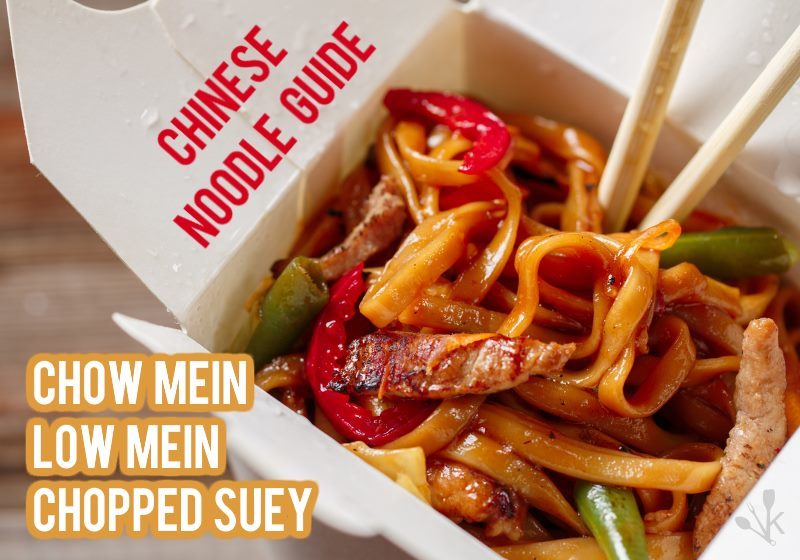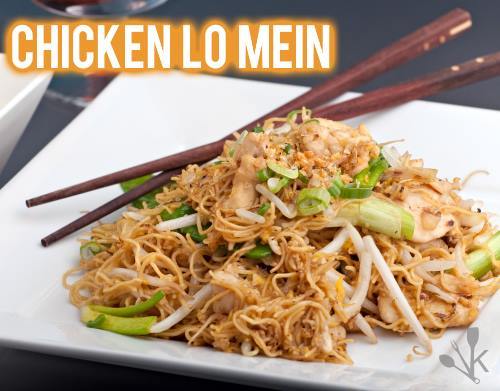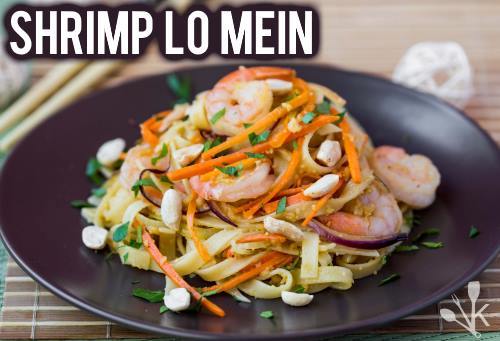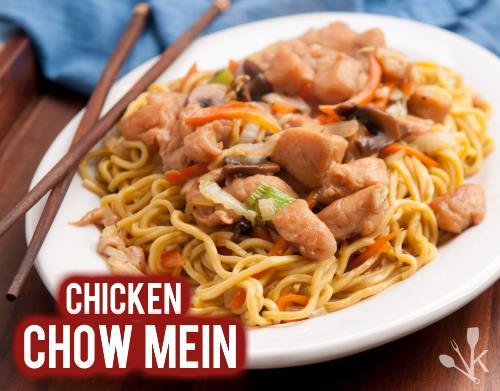What is the difference between these Chinese food dishes? Chow mein and lo mein both use noodles (mein) while chop suey is generally served over rice.
All of these dishes are comprised of chopped vegetables, may include a meat-based protein, and are enhanced with a sauce. They’re quick to prepare and easy to customize to your taste.

| Chinese Food | Type Of Dish | Noodle Texture | Size | Recommended |
|---|---|---|---|---|
| Chow Mein | Fried Noodles | Crispy Noodles | Thin | Use Thin Egg Noodles |
| Lo Mein | Tossed Noodles | Soft Noodles | Various | Try Gluten Free Noodles |
| Chop Suey | Sauce Over Rice | Regular or Sticky Rice | Short Grain or Long Grain | Try Using Noodles |
What Is Lo mein?
In Chinese cooking culture, Lo Mein translates to “tossed noodles” and that’s how lo mein is cooked; boil your noodles, prepare your vegetables, protein and sauce separately, then toss it all together before you serve it.
Peanut butter is a common addition to many lo mein sauces, particularly vegetarian and vegan recipes, as suggested by cooking authorities with OneGreenPlanet.
It should be noted that lo mein can be quite high in carbs and may be high in fat and salt. This hearty dish is also quick and delicious.
Types Of Lo Mein
Chicken Lo Mein

Whenever you prepare one pot dishes with chicken, you’ll need to handle the raw chicken carefully.
Because lo mein cooks quickly, be sure to have all vegetables chopped and ready to add to your skillet or wok.
Using a separate cutting board or kitchen shears, cut your chicken into thin strips that can be fried up quickly.
Beef Lo Mein

You’ll want to work with very thin strips of beef and then marinate once it’s sliced.
Try a simple marinade with a little soy sauce, some ginger and a bit of honey, as well as a splash of balsamic vinegar. This marinade is intended for a whole steak, not thin sliced beef.
You could make your lo mein with leftover beef, or cook the steak separately, slice it and toss it with the noodles and vegetables at the table.
Shrimp Lo Mein

Shrimp flesh is delicate and sweet, requiring a light touch with seasoning. Shrimp also can’t tolerate a lot of exposure to heat without turning chewy and tough.
Make certain your noodles are cooked and ready to drain before adding vegetables and shrimp to the skillet.
Once you’ve quick-tended the vegetables and shrimp until the shrimp start to pink up, you can drain the noodles, whisk in the sauce and serve.
Pork Lo Mein
Experts in the chemistry of cooking at Serious Eats offer a simple method for protecting the meat from drying out as well as adding flavor.
Pork, like beef, can get chewy and tough when sliced thin and exposed to heat. However, pork will marinade quickly.
Make sure to marinade, now drown, your meat or it will steam instead of fry in the cooking process. If you need something fried and crispy to go with your lo mein, see our guide on spring rolls vs egg rolls to pair with your meal.
Vegetable Lo Mein vs Chow Mein

Lo mein means tossed noodle and is a blended dish. Chow mein fried noodles serve as a next or base for the vegetables and oyster sauce.
The fundamental difference between the two dishes is the type of noodle and when you add it. Chow mein noodles are a deliciously crisp addition to the top of your vegetables and sauce.
Related | Does Oyster Sauce Go Bad?
Is Lo Mein Healthy?
How Many Carbs In Lo Mein?
There are 14 grams of carbohydrates in 2 ounces of pasta. In addition, sauces made from oil rich products such as peanut butter can also pile on the calories.
If calories are a concern, consider adding your pasta at the table so that your diners can go light on the carbs if they choose.
If you add extra vegetables to reduce carbs per bite, you may need more sauce.
Is Lo Mein Gluten Free – Noodle Options?
There are many wheat-free noodles on the market, particularly suited to Asian cuisine.
From hearty soba noodles made from buckwheat to rice noodles, gluten free pasta isn’t hard to find.
Be sure to check your labels; some soba noodles contain wheat! Food authorities with TheKitchn have a helpful list.
SEE ALSO: Does Flour Go Bad? & Flour Substitutes
How To Make Lo Mein
As with chop suey and chow mein, the most important step in making lo mein starts at the cutting board.
Do not start the noodles and expect to have time to chop vegetables; have everything ready to go before your even boil the water.
Prepare a simple sauce, chop your vegetables and slice or devein your chosen protein. Now you’re ready to boil water and heat the oil!
What Is Chow Mein?

Chow (fried) mein (noodles) are crisp strands of egg noodles, traditionally cooked in a flat pan. We’ve previously covered some of the best nonstick pans and would recommended a heavy bottom that can tolerate the extra heat.
Boiling the noodles until slightly softened, then rinsing them in cold water and tossing them in sesame oil before frying is the most recommended way to prepare them.
What Kind Of Noodles Are In Chow Mein? Egg noodles are recommended. The critical point is that they are thin.
You’re going to fry them until crispy and flip them so they can serve as a nest for your protein and vegetables; thin noodles will gain a better texture from frying.
Types of Chow Mein
You can prepare your chow mein with any protein that can be sliced thin and fried quickly.
- For chicken chow mein, handle your chicken with care to avoid contamination.
- Make certain to marinade your beef to keep it moist.
- Vegetable chow mein offers plenty of flexibility; just be sure to use enough sauce so your vegetables gain full benefit from the flavor of the sauce.
Is Chow Mein Healthy?
Sauces can add sodium and fat; noodles are high in carbohydrates and may contain gluten.
Finally, the whole dish is fried. If you’re working to cut down on your carb intake, any dish with noodles might not be your best bet.
However, this dish is delicious. It may be worth saving your carbs for your chow mein!
Difference between chow mein and lo mein

Both noodles are boiled, but chow mein crispy noodles are fried into a nest or pancake after a partial boiling while lo mein noodles (generally thicker like corn or potato starch) are tossed into the vegetable/protein combination.
SEE ALSO: Cornstarch Substitute
Literally, the crispy noodles Chinese name is chow (fried) mein (noodle).
- Chow mein means fried noodles. These noodles are boiled until softened but drained before they’re completely cooked, then pressed into a skillet and fried crisp in hot oil.
- Lo mein means tossed noodles. These noodles are boiled until done and mixed with the vegetable/protein/sauce mix.
How To Make Chow Mein
Make sure all ingredients are sliced, chopped, or marinated before you heat anything up.
Prepare your sauce ahead of time. You want everything ready to go into the oil before heating wok or skillet! The following video recipe makes this dish easy to prepare.
Here’s more traditional way:
- Boil the noodles lightly, drain and toss in cold water. Drain again very well.
- Heat the oil in a flat skillet and place the drained noodles into the hot oil to form a pancake. Be sure that the noodles are drained well because water and hot oil is a recipe for disaster which can cause fire or personal injury!
- When you’re ready to flip them, place a large plate over the noodles and turn over carefully.
- Slide the turned noodles back into the pan and fry the other side. At the same time, you’ll be quick-tending vegetables and your protein, then adding sauce.
What Is Chop Suey? Chop Suey Definition
Where was chop suey invented? It’s actually an American dish. Historically, chop suey is believed to be a dish created in the United States by Chinese laborers from the Guangdong Province in the mid-1800s.

While chopped suey is most commonly served over rice in the United States today, the original dish was noodle based.
Is chop Suey Chinese food?
It’s believed that the laborers who created chop suey were hungry for the food of their homeland; when they arrived here, they simply created their favorite dishes from home with the ingredients they found here.
It’s said that American cuisine is a melting pot and when you look at how things actually came together, it’s more of a salad, with foods from all over the world getting tossed into a big bowl and coated with a little ingenuity.
Is Chop Suey Healthy?
When prepared with plenty of vegetables, this can be a hearty, healthy dish. It’s important to note that anything with soy sauce or a heavy sauce can be very high in sodium.
Prepare your sauces with care if sodium is a worry. If carbs are a concern for you or your diners, prepare your chop suey vegetable and protein dish, then allow each diner to choose the amount of noodles or rice they need.
Difference between chop suey and chow mein: Chow mein is made with a nest of thin fried noodles; chop suey is served over boiled noodles or rice. However, each of these dishes is based on vegetables, a sauce and a protein if desired.
Is Chop Suey In A Can Good?
Canned chop suey can make mealtime very quick. La Choy Chop Suey has long been a staple of American cooks.
You can heat this product and serve it directly over rice or noodles for a very quick meal, or you can use this product as a flavorful base to which you add fresh vegetables and a protein.
For most diners, this versatile product is helpful to have in the cupboard. However, if sodium or MSG (monosodium glutamate) is a concern, you’re better off to start your chop suey from scratch.
How To Make Chop Suey Chinese Food
Experts with NoRecipes.com recommend you get all your ingredients prepared for cooking before you approach the stove.
Their chop suey recipe features a marinated pork protein and a light, slightly sweet sauce thickened with potato starch to keep it clear.
Final Thoughts
If you plan on cooking these dishes yourself, be ready for a little smoke and some spatter. Frying both the noodles and your vegetable/protein combination can get messy.
Remember, if you fry with the lid on, you may wind up steaming your food. You need to keep everything well coated in oil, and keep it hot. It’s worth the mess!
Cook safely! If you’re handling raw meat and vegetables in the same area, prepare any salad or uncooked foods ahead of time and in another area of your kitchen.
In addition to cooking meats to the proper temperature (145 degrees Fahrenheit / 63 degrees Celsius for beef and pork, 165 degrees Fahrenheit / 74 degrees Celsius for chicken) treat your leftover marinade with care. If you plan to use it for sauce, boil it well first.
Vegetables, a protein, a sauce, a carbohydrate and cooking speed. With these ingredients, some oil and heat you can create terrific dishes in a wide array of flavors.
From the sweetness of snap peas to the slight spice of stir fried celery to the earthy luxury of mushrooms, all of these dishes can be customized to your taste.
Marinate the meats, don’t overcook the shrimp, and most important of all, make sure you have everything ready to cook before you heat up oil or water!
Which Chinese food dish do you prefer? Let us know in the comments with your favorite ingredients for these dishes and any tips for those looking to tackle recipes on their own.












